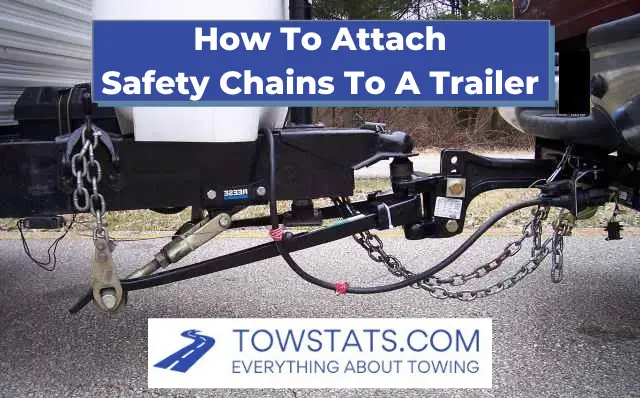If you are towing anything, it is important to know how to attach safety chains to a trailer. This can help prevent accidents and keep you and your passengers safe.
In this guide, we will walk you through the step-by-step process of attaching safety chains to a trailer.
We ‘ll also provide some tips on how to do it correctly and some instruction on how to choose the right towing safety chain for your situation.
How To Attach Safety Chains To A Trailer
Fortunately, hooking up safety chains to your trailer and tow vehicle is really simple and only takes about five minutes.
We’ll walk through each step and detail them out to make it foolproof.
Step 1: Get Your Supplies
You’ll need the following supplies:
- Your Tow Vehicle
- Safety Chains
- S-Hooks
Get those together, and we’ll move on to the next step.
Step 2: Connect Your Safety Chains To The Trailer
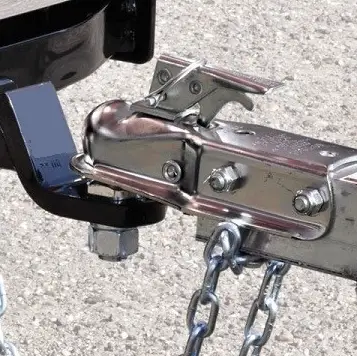
Your trailer should have some brackets welded into it on each side of the trailer tongue or on the frame near the tongue.
Connect the open end of an S-hook on each side of the trailer using the brackets, with the S-hooks facing down.
Step 3: Cross The Chains Underneath The Trailer Tongue
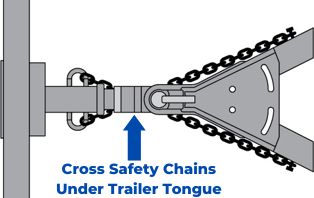
Once you’ve hooked the chains up to each side of your trailer, cross them underneath the trailer tongue as you prepare to connect them to your vehicle.
Crossing the chains is required by law in some states and can prevent damage to your trailer in case the coupler comes loose while towing.
Step 4: Connect The Safety Chains To Your Tow Vehicle
Secure the safety chains to your tow vehicle using the vehicle’s hitch, frame, or bumper brackets.
Your vehicle’s tow hitch may have brackets welded on to it.
If so, connect the S-hooks on the end of your safety chains to those brackets facing downward.
It’s also ideal to have the S-hooks facing toward the trailer if possible.
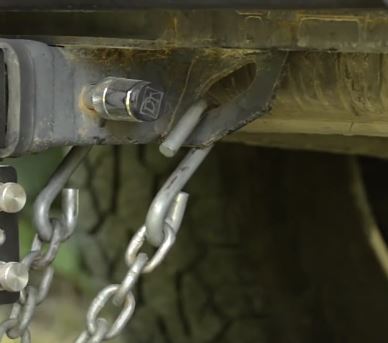
If your tow hitch doesn’t have brackets, you can find spots on the frame of your vehicle where you can hook up the chains.
You may need to get under the vehicle and use a flashlight to find an appropriate spot for the chains.
If all else fails, you can hook the towing safety chains to your vehicle by using the bumper brackets.
Step 5: Inspect The Chains For Damage
You should inspect the chains before and after each towing session to ensure that there are no defects in the towing safety chain.
If you find any, replace the chains immediately.
Why Is It Important To Use Trailer Safety Chains?
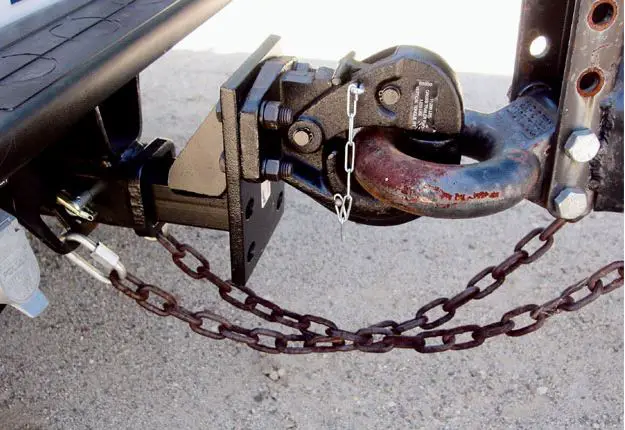
There are a few very important reasons that you should always use safety chains, which we’ll cover now.
It’s The Law
There are federal and state towing safety chain laws requiring their use when towing a trailer.
So you should always use safety chains at the very least to keep yourself out of trouble and avoid a ticket.
Safety
Trailer chains are a failsafe if the trailer comes unhooked from your trailer while towing.
Without safety chains the trailer could go anywhere, including into another lane or oncoming traffic, causing a serious accident.
Protect Your Trailer And Cargo
Although this is the least important reason, it’s still worth mentioning.
Having a backup method in case of trailer couple failure ensures that your trailer and the property on it doesn’t sustain further damage if the trailer comes loose.
Should Trailer Safety Chains Be Crossed?
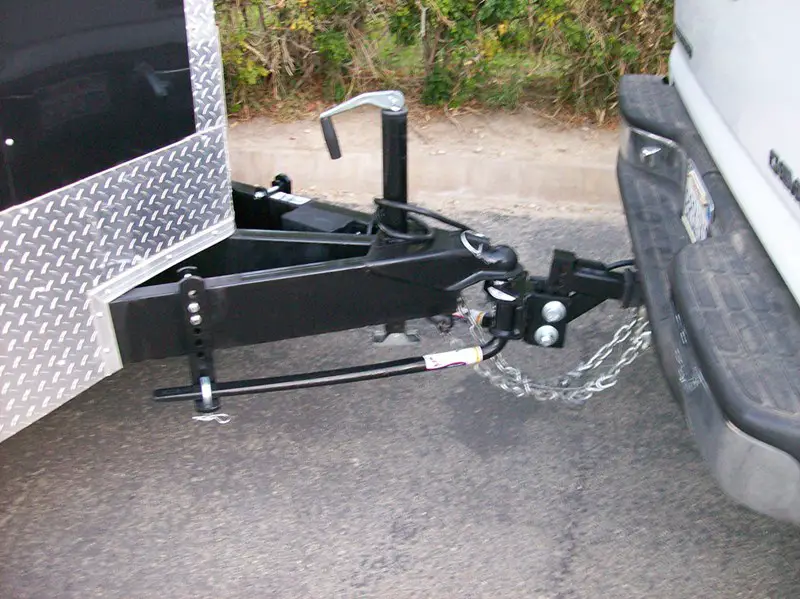
Many of our readers write to ask us: why do you cross the safety chains on a trailer?
Crossing the safety chains on a trailer helps the chains act as a harness below the trailer tongue, which can keep it from dragging on the ground and getting further damaged if the trailer gets detached from the tow vehicle.
Some states even require that you cross your tow chains for this reason.
How Long Should Safety Chains Be?
Safety chains should be long enough to provide enough slack so there is no tension on the chain while turning, but short enough so that there is no part of the safety chain dragging on the ground while towing.
Shorter chains are easier to keep under control in emergency situations and keeps impact down when the chain is tightened.
What Class Safety Chain Do I Need?
Safety chains come in multiple classes that are rated for different weight limits, similar to trailer hitches.
Your safety chain should always be equal to or greater than the Gross Vehicle Weight Rating (GVWR) of your trailer.
So for example, if you’re using a Class 2 hitch that has a max GTW of 3,000 lbs, you’ll need your safety chains to be rated for at least 3,000 lbs.
Here are the different trailer safety chain classes:
- Class 1: 3,000 lbs GVWR
- Class 2: 3,500 lbs GVWR
- Class 3: 5,000 lbs GVWR
Here’s a good reference for trailer safety chain working load limits:
Trailer Safety Chain Working Load Limit In Pounds (lbs.)
| Chain Size (Inches) | Grade 30 | Grade 43 | Grade 70 | Grade 80 | Grade 100 |
|---|---|---|---|---|---|
| 1/4" | 1,300 | 2,600 | 3,150 | 3,500 | 4,300 |
| 5/16" | 1,900 | 3,900 | 4,700 | 4,500 | 5,700 |
| 3/8" | 2,650 | 5,400 | 6,600 | 7,100 | 8,800 |
| 7/16" | 3,700 | 7,200 | 8,750 | N/A | N/A |
| 1/2" | 4,500 | 9,200 | 11,300 | 12,000 | 15,000 |
| 5/8" | 6,900 | 13,000 | 15,800 | 18,100 | 22,600 |
You also need to make sure your hooks are rated for the same weight limit.
Where To Attach Safety Chains On A Trailer
Some trailers will have brackets welded into the side of the tongue where you can attach the safety chains to the trailer.
Many times, trailer safety chains are attached to the bottom of the trailer tongue or to a guard that’s welded to the trailer tongue’s bottom.
Attaching the chains to the side of the tongue as far forward as possible is the best option because it reduces the chance that they’ll be ground off if the coupler comes loose during transport.
Ideally you will be able to permanently fasten these chains to your trailer tongue with grade 8 bolts, but it’s not a deal breaker if you can’t.
Is Twisting Safety Chains Okay?
You should never twist safety chains to make up for extra slack or for any other reason.
Twisting chains puts more stress on the links, making them more likely to fail and wear out faster.
If you need to shorten a trailer safety chain, gather the excess links and use a zip tie instead.
Key Tips On Choosing Safety Chains For Trailers
First, always choose chains that are equal to or stronger than the total weight of the trailer you’re pulling.
Next, always keep chains from dragging on the ground while you’re towing.
Also, never weld the chains to your trailer tongue, as this will weaken the chain and defeat their purpose.
Make your safety chains as short as possible while still allowing enough slack for full turning.
Don’t loop the chains back on each other or twist them to shorten slack – use zip ties instead.
Cables are permitted for use in many states, but they’re not nearly as reliable as chains.

